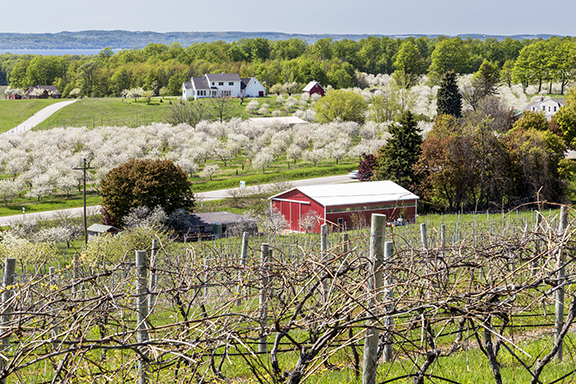
Rural Michigan cooperatives set the standard for carbon emissions reporting
Heralded as both a future safe haven and a laggard in climate solutions, Michigan's changing climate landscape isn't easily understood from the outside. 94% of the state's land mass is rural, though only about 20% of the population lives on rural land.
Rural communities are diverse in cultural identity and way of life and share deep concerns about population decline, unstable economic systems, and being left behind as the rest of the country moves towards new solutions based on different realities.
They need solutions to improve resilience and to help them adapt to very real concerns around changing weather patterns that impact agriculture and other industries central to their lives.
While the language around priorities may differ, Cloverland Electric Cooperative, Great Lakes Energy Electric Cooperative, HomeWorks Tri-County Electric Cooperative, and Presque Isle Electric & Gas Cooperative (PIE&G) lead the way toward Michigan's clean energy goals, even without legislative influence.
And they have the carbon emissions data to prove it.
The energy landscape of rural Michigan
"As a rural electric utility with about seven members per mile of line, we don't have a lot of room to reduce our energy consumption. It's already low," explains PIE&G CEO Tom Sobeck. "But we can report a much lower carbon footprint."
Distance between meters, coupled with vegetation management and extreme weather, makes it difficult to deliver energy to rural areas. In many cases, they are powered by municipalities and cooperatives born because other energy service providers would not serve them.
Rural communities are often labeled "hard-to-reach," but HomeWorks CEO Chris O'Neill reports a much different reality. "Members are open to trying new technologies — and eager to do so — but they can have trouble paying for them. It's important we help lower the barrier to participate with the technologies they value."
Sometimes measures that result in kWh savings are not the same measures that impact GHG emissions. A program designed to reduce carbon can open pathways for clean technologies that are appropriate for the market, which has proven impactful for rural Michigan.
For example, electric lawn equipment and chainsaws are measures that deliver zero kWh savings. They typically aren't incentivized with traditional energy waste reduction programs because of that. However, those same technologies offer major impact on our carbon reduction goals and are a tangible decarbonization entry point that aligns with market desires.
Members are open to trying new technologies — and eager to do so — but they can have trouble paying for them. It's important we help lower the barrier to participate with the technologies they value.
A legislative sunset for cooperatives and municipalities in 2021 brought Slipstream's ten-year partnership with Michigan Electric Cooperative Association (MECA) to an end.
Even without a legislative mandate, four electric cooperatives continued to work with Slipstream to deliver important energy and cost savings to their members, this time with support for fuel switching and beneficial education.
In 2022 the co-ops began to assess their carbon emissions reductions with a methodology Slipstream designed for carbon emissions reporting to offer more accuracy than an online calculator by determining emissions at the measure level based on the fuel type replaced.
Utility energy efficiency programs can advance carbon reduction
Energy efficiency programs excel at saving energy for the buildings that access them and successfully help participants use less energy and save money.
However, the energy industry has called for utilities to revamp efficiency programs to prioritize lower greenhouse gas (GHG) emissions. Though many energy providers have made climate pledges, systems to measure progress have not yet proliferated within the industry.
Local, state, and national climate action plans pave the way to decarbonize our buildings, power grid, and transportation networks and define measurable carbon reduction goals.
Shouldn't assessment protocols hold us accountable to those same goals?
"PIE&G advocates for carbon emissions reporting," explains Tom. "Historically, we focused on energy waste reduction, but regulatory and legislative bodies are beginning to talk about carbon. And I don't believe they know about the leadership co-ops have on carbon reporting."
"The members lead us where we need to go."
The beauty of co-ops is that they are responsible for and responsive to their members, making their program design inherently flexible.
"HomeWorks will continue to deliver programs that help members try on different technologies and reduce their carbon emissions." Chris says. "The members lead us where we need to go."
Decarbonization – the evolution of energy efficiency
With energy efficiency programs designed to include fuel-switching measures and a focus on beneficial electrification, the four cooperatives (and their members) saved 2,901 tons of carbon in one year.
Their decarbonization efforts make them leaders amongst Michigan utilities and a leader in progress made fulfilling objectives laid out in Governor Whitmer's MI Healthy Climate Plan, which tasks the state to reach carbon neutrality by 2050 with actions between now and 2030.
"I visit about twenty townships in PIE&G territory a year to report on kWh savings and carbon reduction," explains Tom. "People are often surprised – including myself – with the amount of carbon we reduce."
Perhaps most powerful about the cooperatives' carbon emissions reporting leadership is the impact it will have on public education around carbon and our responsibility to drive change.
Energy efficiency programs have a long history of effectively delivering cost and energy savings through avenues people trust. Energy service providers can adapt that already successful framework to help advance climate mitigation and adaptation goals.
Solutions are most effective when designed for the people who will benefit from them and places where they will be implemented. We celebrate our rural Michigan electric cooperative partners for tracking and reporting their programs' impact toward lower carbon emissions. Their successful progress toward Michigan's climate and clean energy goals is because they listened to their members and designed measures and metrics to meet those needs.